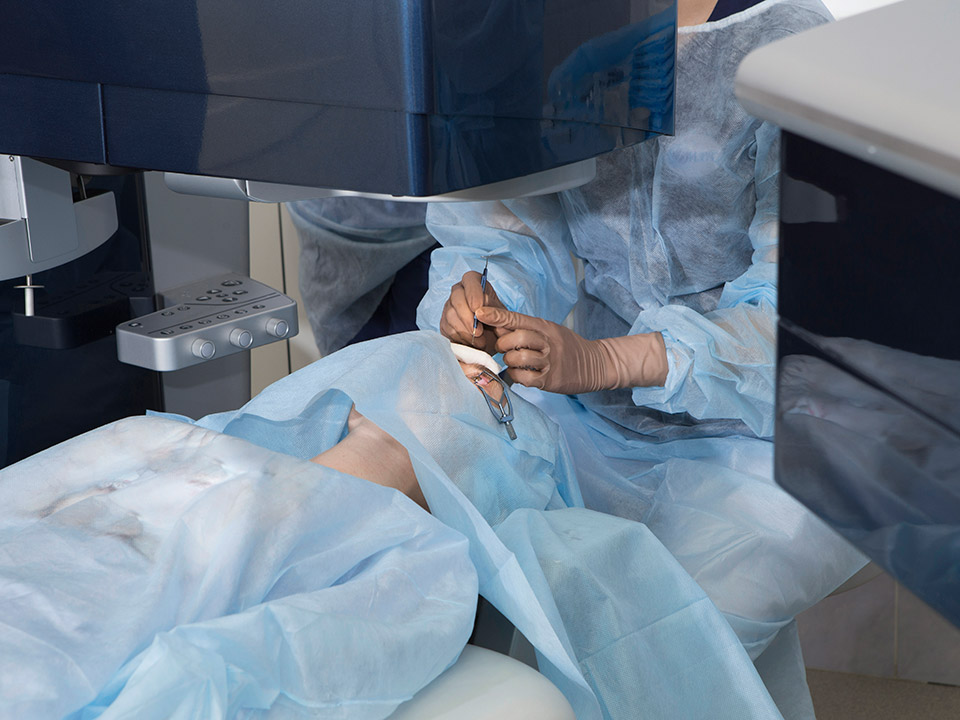
Strabismus Surgery
Strabismus surgery occurs when the two eyes cannot achieve the proper alignment to focus on an object known as crossed eyes. One eye turns in a different direction and the other eye is generally able to look directly at the object. Strabismus surgery involves tightening or loosening the eye muscles to achieve proper alignment of the eyes. Strabismus surgery is recommended for all types of the eye turns, including hypertropia, hypotropia, esotropia, and exotropia. Strabismus surgery is 80 to 90% effective all the time. It will require multiple procedures for optimal results for some patients depending on their age and type of strabismus.
Advantages of Strabismus Surgery
Strabismus surgery is an effective way to improve eye alignment. If you or your child has been diagnosed with strabismus, it becomes difficult to stimulate the two eyes to work together for clear vision; however, it is important to understand that while surgery will correct the turn of the eyes and help your eyes appear aligned. To improve eye coordination and teaming skills, which will also ensure that the eye remains aligned, your eye doctor may recommend a program of vision therapy. A recession procedure is used when the muscle is too tight, detaching the affected extraocular muscle from the eye and reattaching it farther back on the eye, this procedure involves relocating the muscle to a different area. The muscle is weakened, leading to improved alignment if its position is altered. When the muscle is too weak to hold the eye in its proper place and consequently causes the eye to turn, then resection is used. It involves strengthening the extraocular muscle by shortening it and then reattaching it to its original position. The adjustable suture procedure is performed as a recession or resection procedure in which adjustable sutures were used. The surgeon adjusts the sutures during this procedure that holds the extraocular muscle in place and either tightens or loosens them to improve the surgical results and achievement of optimal alignment. The patient remains awake only a local anesthetic during the procedure and this surgery is generally performed only in adults. A regular suture is typically used for children with strabismus. Within about six weeks all sutures will dissolve on their own. The risk associated with strabismus surgery, while all surgical procedures carry risks, including infection, bleeding, or excessive scarring, is low. Correction or overcorrection are the main risks of strabismus surgery. Complications that lead to vision loss are very rare. Adults usually receive local anesthesia, while most children undergo general anesthesia.
Specifics about Strabismus Surgery
Strabismus surgery is performed in a surgical center or hospital and is typically an outpatient procedure. Your eyes will be red and sore after strabismus surgery. In the surgical area, you may notice blood in the inside or outside corner of your eye; this is normal and will subside within two to three weeks. Many eye doctors will prescribe an antibiotic eye drop or ointment to be used for a few days after surgery, including light sensitivity, swollen eyelids mild blurry vision, double vision, make sure to use your medication as directed by your doctor to avoid postoperative complications. When it is safe to resume normal activities, your doctor will inform you, usually within a few days after surgery. To reduce your risk of infection, avoid saunas, swimming pools, and hot tubs for at least three weeks after surgery. You can indicate the problem of symptoms by looking for signs of infection or slipped muscle within the first week after surgery. If you notice any of these symptoms like vision loss increasing redness green discharge severe pain during eye movement inability to move your eye, contact an eye doctor or emergency medical services immediately. You should know if the surgery was successful, the first few days after surgery will be a good indication of the success of the surgery. Until your eye has healed, the alignment of the eye can change over time and the outcome of surgery may not be confirmed, typically around six weeks after surgery. Under the age of 10, most children will need to obtain optimal results in multiple procedures. Strabismus surgery, eye muscle surgery is performed on adults or children to treat misaligned eyes when nonsurgical treatment is ineffective. It is also ineffective, such as patching means occlusion, prisms, botulinum toxin injection, fogging, monocular occlusion, and in some cases eye exercise. Eye misalignment or strabismus is marked by eyes that do not move together normally, which is caused by intraocular muscle imbalance. The muscles attached to the eye work together to move the eyes in the same direction at the same time when the eyes function properly. During the time of rest, strabismus causes muscles to function improperly, leaving individuals unable to control eye movement. Since it is most commonly seen in infants, young children and adults can develop it too, specialists in pediatric ophthalmology often treat strabismus.




